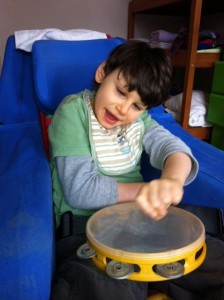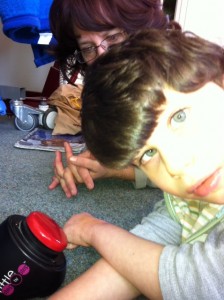Lynlee Pendrigh, Resource Teacher Vision is engaging Alex, in a favourite song, so that Alex can direct the interaction by communicating ‘more’ by touching Lynlee.
In figure 1 Alex is asking for more.
He can also communicate ‘more’ by turn taking on an instrument as many times as he wants to and by pressing his “Step by Step”, where ‘more’ is spoken.
Alex is a 7 year old homeschooled, complex needs learner with cerebral palsy and cerebral vision impairment.
Communicating ‘more’ in different situations
Alex is learning to generalize communicating ‘more,’ with other people, in different interactions. This second way that Alex can communicate ‘more’ is by continuing to turn take on an instrument without any cues.
Alex is beating a tambourine. He indicates that he wants ‘more’ by continuing to take his turns after pausing for the other person to take a turn.
In figure 2 Alex is beating a tambourine.
Prerequisite skills
Alex was able to use his left hand to tap his mum to get her attention. Alex was able to turn-take on musical instruments and his switch with and without cues. He was able to think about how to continue and wait in the activity.
Possible next steps
- Alex will tap an instrument when he wants the turn taking to continue with 2 other participants.
- Alex will tap other participants, besides Lynlee, when he wants ‘more’ so that he is directing the activity himself.
- Alex will tap ‘more’ each time he wants the song or rhyme to be repeated.
- Alex will communicate ‘no’.
Teaching methods and strategies
- Alex had initially been teacher directed and given verbal or partial physical prompts. The turn taking was on musical instruments or on his switch.
- Alex becomes anxious when presented with new sensory experiences and needs familiar items around him for support.
- I used hand under hand to help Alex tap twice, because he taps once for ‘yes’.
Figure 3 shows Alex using a switch.
Intensive Interaction techniques for Communication:
- Chose a favourite rhyme or song to engage Alex.
- Lying next to him on floor, allowing him personal space and therefore the choice to engage by moving closer.
- Burst/pause technique-engagement and the time for Alex to respond.
- Repetition of song/rhyme as many times as Alex asks for ‘more’.
- Said: “You said, more Lynlee, more.”
- Focussed on hands and fingers with rhymes like “Round and Round the Garden” and “This Little Piggy”.
- Opportunities to hold different hoops of various materials while singing “The Wheels on the Bus.”
- Said: “Give me your hand”, “Look, I am holding your hand”.
Learning adaptations
Alex has cortical vision impairment and a right eye inward squint. Presentation of objects, needed to be within 30 cms and well contrasted so that they did not merge with the background.
Objects needed to be placed centrally or to the left of centre. Lynlee was wearing black as a contrast to objects, when she was showing them to Alex.
Black calico was used to cover up ‘busy’ parts of the room, that might have impeded Alex’s ability to discriminate between close items and the background.
Assessment
I had researched “Intensive Interaction” as described by Dave Hewett and Melanie Nind. I wanted our learning sessions and communication to be more student directed, rather than teacher directed.
I wanted Alex to have the choice of continuing the activity or bringing an end to it. I wanted the sequences to be at his pace and for the sessions to be enjoyable for both of us. I recorded the sessions on the interaction recording sheets and found that the strategies were successful in engaging Alex.
Useful Links
- Quest for learning: Guidance & Assessment Materials – Profound & Multiple Learning Difficulties 2011 – PDF
- What is Active Learning and Lilliworks – YouTube.
- Intensive Interaction: “So… what is Intensive Interaction?” Interview with Dave Hewett – YouTube.
More information
Email us at BLENNZ for more information about this subject.
We will link you up with either the author of this post or another BLENNZ colleague with whom you can continue your conversation.



